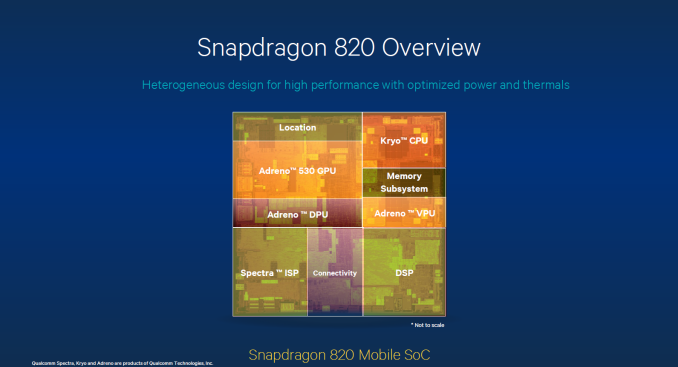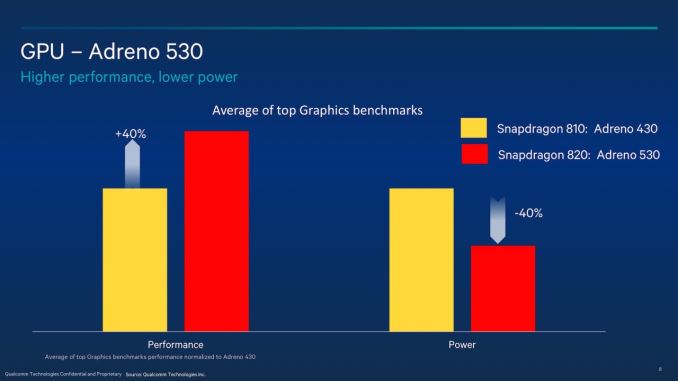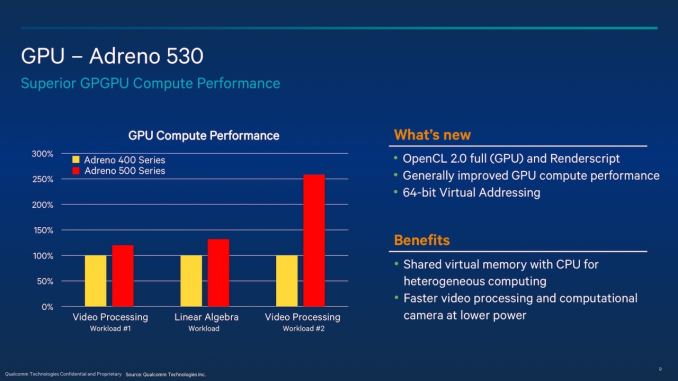Qualcomm Details the Adreno 530 GPU and ISP inside the Snapdragon 820
by Brandon Chester on August 12, 2015 9:35 AM EST- Posted in
- Smartphones
- Adreno
- Mobile
- Tablets
- Snapdragon 820

Snapdragon 820 is still a mystery as far as official information from Qualcomm goes. However, today Qualcomm has given a bit of insight into their upcoming SoC. While there's still no information about the CPU portion featuring Qualcomm's custom 64-bit cores known as 'Kryo', there are some details about the Adreno 510 and 530 GPUs, as well as Qualcomm's Spectra image signal processor.
Because Adreno 530 is their new flagship GPU, Qualcomm's press release focuses more on the 530 than the 510. The performance figures released by Qualcomm describe Adreno 530 as being 40% faster than Adreno 430 on average, while also consuming 40% less power. This result is described as an average of "the top graphics benchmarks", and while it's still generally a good idea to take vendor provided numbers with a grain of salt, if the power and performance gains over Adreno 430 are anywhere in the ballpark of Qualcomm's 40% figure then Adreno 530 should end up being quite impressive.
On the API side, Adreno 500 series GPUs will support OpenGL ES 3.1 + AEP (Android Extension Pack), Renderscript, Vulkan, and OpenCL 2.0. With OpenCL 2.0 comes support for Shared Virtual Memory (SVP), which allows an OpenCL host program and a device's kernel to share a virtual address space so access to data structures like lists and trees can be easily shared between the host and GPU. Adreno 530 has varying improvements to GPGPU performance when compared to Adreno 430, but Qualcomm's slides show video processing as demonstrating the greatest improvement with a 2.5x increase in compute performance. This is also the area where efficiency gains for generational improvements typically happen, so we expect fixed-function codec support although this information is not yet provided.
As for the ISP, it's still the case that mobile image signal processors are black boxes. Qualcomm is stating that their Spectra ISP in Snapdragon 820 will be able to support 3 simultaneous cameras at up to 25MP and at 30fps with no shutter lag. The Spectra ISP will also use MIPI's higher bandwidth C-PHY serial interface, which supports the enhanced camera support. As well as this, new developer and user-facing features include support and APIs for depth maps and using dual cameras to perform refocusing or other visual effects - because Qualcomm is just the SoC manufacturer, it is up to the smartphone OEMs to implement dual-camera/depth-maps as a feature as well.
According to Qualcomm, Snapdragon 820 will start showing up in devices during the first half of 2016. Hopefully between now and then there's more information from Qualcomm about the other aspects of their new SoC, including their Kryo custom CPU core. In Q1 we will be at Mobile World Congress, so we may see more information at that time.












66 Comments
View All Comments
jjj - Wednesday, August 12, 2015 - link
Sounds like you just want a 150$ device with a fast SoC and that might be doable next year if anyone makes a compact 20$ SoC with dual A72 + some A53s on 16ff. Others might want higher res screen, LTE cat 145_millions_nobody_cares, 18.52GB of RAM, 26MP front cam , fingeprint sensor, hiccup counter and an imaginary integrated jetpack plus a GPU that can push 240FPS on a screen that can't go above 60. When it comes to it lots of things can be considered over-the-top. But you also need to keep some kind of balance when you oppose better specs. Sometimes maybe the problem is you and being a bit more open minded is preferable.I will insist that people don't need good audio hardware for stupid 320kbps or less streams, if the source is poor, decent hardware is more than enough. If you listen to flac then it makes sense but for mp3 it's just pointless.
On the GPU side folks would need to push anyway no matter the res. Photo realism is not even close so there is no good enough in sight.
I don't consider Pentile to be the advertise res. A pixel should be RggB (2 small green ones) not just faked out of 2 subpixels and that would mean the screen is actually half the advertised pixels and bellow 1080p real res while the faked pixels do help a bit to simulate a higher res.
PS: wish Anandtech would look at the Meizu M2 Note, seems like the screen is pretty good especially for budget - under 130$ with a 5.5 inch 1080p Sharp IZGO that appears to have decent calibration. Next year if we had a cheap and fast SoC such phones could be awesome.
name99 - Wednesday, August 12, 2015 - link
"Photo realism is not even close so there is no good enough in sight."The point is not that no-one wants photo-realism, or video-realism, it's that there are sensible tradeoffs and there are stupid tradeoffs.
Ine the space of video, right now what's needed to improve video (on anything smaller than 30" or so) is a higher frame rate for the source content, not a higher number of pixels.
In the space of photos, what's needed is a wider color gamut (perhaps achieved through the addition of one, and perhaps as many three, extra "base phosphors") and an increase to either 12 bit nonlinear pixel values (tricky to manipulate) or 16 bit linear pixel values.
Essentially you're like a guy listening to audio at 8b/sample, sampled at 96kSamples/sec, and you're urging that to improve the sound what is needed is to sample at 128kSamples/sec,. Uh, no; what is needed is more accurate samples, not lousy samples acquired at an even higher rate.
lilmoe - Wednesday, August 12, 2015 - link
"In the space of video, right now what's needed to improve video is a higher frame rate for the source content, not a higher number of pixels. In the space of photos, what's needed is a wider color gamut"+1
That would be a good start. Most OEMs and content providers nowadays are offloading all their work to engineers that design cheap, generic and profitable parts, and are building their products around them (yet ironically mostly aren't profitable overall). This is a huge problem in today's electronics industry where only "market leaders", part manufacturers, and Chinese OEMs can get away with a profit. There's little to no interest in genuine, affordable, and mainstream quality simply for the lack of "demand". Consumers have no clue what they actually *need*.
Consumers got a clue when when Apple said that thinner, nicer phones are needed. They also got a clue when Samsung said that larger screens are needed. Those were genuine, non-artificial features that consumers now demand and can't live without. Everyone can live without a 5" 4K display, and everyone can live without VR.
What's even more saddening is the lost opportunity for other companies like Microsoft in the time gap between now and the next big feature to be introduced by either Apple or Samsung's Android (sorry Google). They are so late to the party it's sickening. Windows 10 Mobile could very well be what truly enables devices to strike the "perfect balance", featuring the best of what Android and iOS provides... I just hope they arrive there before it's too late.
lilmoe - Wednesday, August 12, 2015 - link
"Sounds like you just want a 150$ device with a fast SoC"No. I want a smartphones that pushes the limits in what matters in daily use and a bit of crazy fun. Again, I believe this is the route OEMs should focus more on:
- 5.x", 120hz, 1080p AMOLED screen with perfect color calibration and great brightness.
- Capacitive touch with <= 1ms delay.
- Better audio. I believe there are more people interested in FLAC than there are in VR, yet they still need to buy a separate device for their audio needs.
- Better imaging sensors, processors and software.
- Better battery tech, or better device layout engineering to fit a larger battery.
- A powerful SoC that can SUSTAIN all of that as EFFICIENTLY as possible. One that doesn't have to throttle in a minute pushing a gazillion pixels and running unoptimized software plagued with tons of lazy programmer overhead.
These parts, and the software running all that is NOT cheap. If you're going to sell me a $700 smartphone, then you need to do the work to make it worth every $$$. I'm not saying that off-the-shelve parts are bad by any means, but an OEM needs to choose the "right" parts to put together if they're no going to design their own.
Samsung had a vision in vertical integration in the past, but they seem to be more of a follower now, and more interested in producing parts that can be sold to other OEMs as well. Apple is the only company left doing things in a relatively more balanced and vertically integrated manner, but even their trade-offs aren't optimal (too thin too soon, and unnecessarily black boxed).
name99 - Wednesday, August 12, 2015 - link
"Capacitive touch with <= 1ms delay"Good luck with that.
Apple has the tightest tuned stack in the industry. Prior to iOS9 they were four 60Hz frames from touch to visual. In iOS9 they have cleaned this up a lot and they're at 2 frames from touch to visual. The iPad Air 2 (and presumably the forthcoming 2015 iOS devices) have a hardware first to double-rate touch sampling, ie touch-sampling at 120fps, and that allows the Air2 on iOS9 to get from touch to visual in 1.5 60 Hz frames.
My point is: it is a reasonable idea to say "I want more responsive touch". But to insist on certain technical parameters when you actually have no idea what realistic values are makes you look like a crazy person and diminishes the strength of your request.
lilmoe - Wednesday, August 12, 2015 - link
"But to insist on certain technical parameters".I wasn't. It was an exaggeration. Sorry if I had offended you.
kspirit - Wednesday, August 12, 2015 - link
You're saying the best value for touch delay we have is with iOS9 at 33.33 ms? That's not a lot. I don't think it's even noticeable. I've never owned budget phones, so I've no clue how bad it is on cheap Android devices.Lumia phones have more delay? What about the Surface pen input? I heard Microsoft is all about improving that touch delay on their hardware
name99 - Thursday, August 13, 2015 - link
33ms on older devices, 24ms on Air2 and higher.It sounds like a lot, but the fundamental processing cycle in your brain is of order 40ms (very vaguely speaking, obviously there are subsystems that can twitch quite a bit faster, but that's the order of magnitude). Vast amounts of what you think are happening at a faster rate than that are being interpolated by your brain. So it's an illusion that works, just like video is an illusion that works.
Azurael - Wednesday, August 19, 2015 - link
I can't say I've ever felt there was too much lag hardware-wise on a device with a capacitive touchscreen, going right back to my original iPhone, in 2007, which must have been the first device I owned with a capacitive touch panel. Other issues (phantom touches, missing touches, poor response dependent upon humidity and temperature, etc) are very common so there are definite (and I would argue more important) improvements to be made to the technology. Of course, there can be inconsistencies if the CPU/GPUs can't action the necessary screen redraws quickly enough, but I think that's a separate issue - I can't imagine changing to a touch panel that reads out at 120Hz alone, for example, is going to benefit most users in any notable fashion?dragonsqrrl - Wednesday, August 12, 2015 - link
"That's what some people said about 720p ,then 1080p and 1440p and they'll keep saying it."And I, along with many other people, would argue that since 1080p they've been right. There's really no need for anything greater than 1080p on ~5" smartphone. That's already over 450 ppi, which is well above the visual acuity of most people. I totally agree that resolutions and pixel density still need to advance for other purposes such as VR, but as far as smart phones go the race is over. I think the sooner certain Android smartphone makers (Samsung) realize this, the better.
And errr, the resolution race hasn't stopped in laptops. In fact outside smartphones laptops were the first devices, along with tablets, to have higher ppi displays. Desktop displays are what have really lagged behind the rest of the industry, but even that is beginning to catch up.